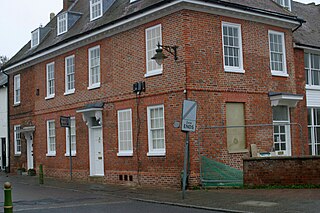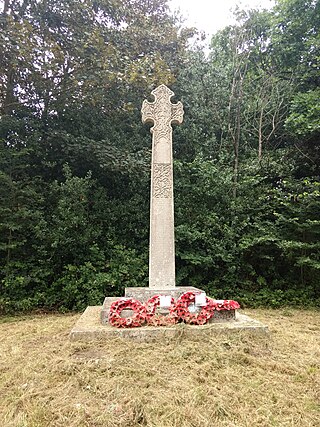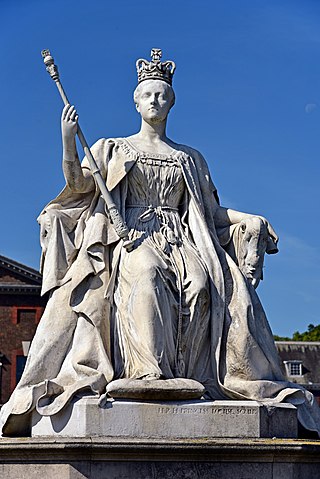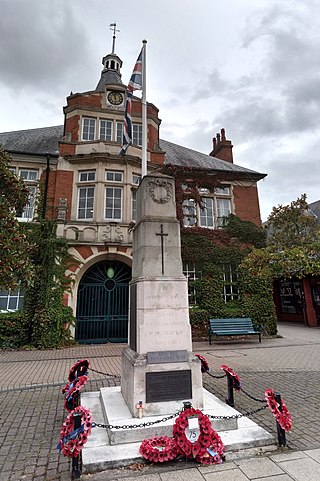
Kensington Gardens, once the private gardens of Kensington Palace, are among the Royal Parks of London. The gardens are shared by the City of Westminster and the Royal Borough of Kensington and Chelsea and sit immediately to the west of Hyde Park, in western central London known as the West End. The gardens cover an area of 107 hectares. The open spaces of Kensington Gardens, Hyde Park, Green Park, and St. James's Park together form an almost continuous "green lung" in the heart of London. Kensington Gardens are Grade I listed on the Register of Historic Parks and Gardens.

The Red House is a Queen Anne style house built around 1710 opposite the intersection of Norfolk Road and High Street in Buntingford, Hertfordshire, England. It was inhabited by artist and stage designer Claud Lovat Fraser, who designed the Buntingford war memorial and other aspects of the town. The building was used by estate agency Churchills, but currently appears unoccupied. It is a Grade II Listed Building.

Cromwell Gardens is a short but major road in South Kensington, within the Royal Borough of Kensington and Chelsea, London, England. It joins the Cromwell Road at the junction with Exhibition Road to the west with the Brompton Road to the east.

Thurloe Square is a traditional garden square in South Kensington, London, England.

The Diana, Princess of Wales Memorial Walk is a 7-mile (11 km) long circular walking trail in central London, England, dedicated to the memory of Diana, Princess of Wales.

Emslie Horniman's Pleasance is a park in Kensal Town, in the Borough of Kensington and Chelsea, London. It is named after Emslie John Horniman the MP for Chelsea who created it. It opened in 1914. The park is the traditional starting point for the Notting Hill Carnival.

Chingford War Memorial is a Grade II listed war memorial cross at the junction of King's Head Hill and The Ridgeway, Chingford, London, E4.

The Anglo-Belgian Memorial, also known as the Belgian Gratitude Memorial, Belgian Refugees Memorial, or the Belgian Monument to the British Nation, is a war memorial on Victoria Embankment in London, opposite Cleopatra's Needle. It was a gift from Belgium, as a mark of thanks for assistance given by the UK during the First World War, and in particular for sheltering thousands of Belgian refugees who fled from the war. It is a Grade II* listed building.

Potters Bar war memorial is located in St John's Churchyard in High Street, Potters Bar, England. The memorial was designed by the Arts and Crafts architect and designer C.F.A. Voysey and originally stood at the junction of Hatfield Road and The Causeway. It has been Grade II listed on the National Heritage List for England since it was moved to its present location in December 1973. Voysey's only other free standing war memorial, the Malvern Wells War Memorial, was erected in 1920 in Malvern Wells in Worcestershire.

The New Barnet War Memorial stands on a triangular plot at the junction of Station Road and Lyonsdown Road, New Barnet. It is grade II listed with Historic England.

The Monken Hadley War Memorial is located immediately to the north of Monken Hadley at the western end of Camlet Way in Monken Hadley Common. It commemorates the men of the district who died in the First and Second World Wars and is in the form of a tapered decorated column with a celtic cross at the top and the names of the dead shown on the shaft. It was unveiled by Francis Fremantle, Member of Parliament for St Albans, in December 1920. It became a Grade II listed building in April 2017.

The principal war memorial in Enfield Town is the cenotaph that stands in Chase Green Gardens and is a grade II listed monument with Historic England. It commemorates men lost in both the World Wars as does a plaque in the town's main post office. In addition, in 2003 a memorial to those lost in the Arctic campaign of the Second World War was unveiled.

Hornsey War Memorial is located in Park Road, Hornsey, in London, in front of the Hornsey Central Neighbourhood Health Centre, formerly the Hornsey Central Hospital, formerly the Hornsey Memorial Hospital. The address in 2023 is 151 Park Rd, London N8 8JD.

The church of Our Lady of Mount Carmel and St Simon Stock is a Roman Catholic church at 41 Kensington Church Street, Kensington, London W8, served by Discalced Carmelites.

The Wood Green War Memorial is located on the High Road, Wood Green, in the London Borough of Haringey. It was erected in 1920 and paid for by public subscription of the people of Wood Green to remember the men of the area who died during the First World War. It was subsequently adapted to include the dead of the Second World War. It is grade II listed with Historic England.

The Lancaster Gate Memorial Cross is a grade II listed war memorial in Lancaster Gate, London, commemorating residents of the Metropolitan Borough of Paddington who died fighting in the First World War.

Arkley War Memorial is a war memorial in Arkley, in the London Borough of Barnet. It was unveiled in 1920 to commemorate World War I, with later additions for World War II. It is grade II listed with Historic England.

Kensington New Town is an area of housing in Kensington, London, which was developed in the early 19th century. It lies to the south of Kensington High Street and to the southwest of Kensington Gardens.

A statue of Queen Victoria stands near Kensington Palace. It was sculpted by Victoria's fourth daughter Princess Louise, Duchess of Argyll and erected in 1893. The statue was made from white marble on a Portland stone base. It depicts Victoria aged 18, seated in her coronation robes, resembling the painting of Victoria at her coronation by Sir George Hayter. The statue received a Grade II listing in 1969.

New Malden War Memorial is a Grade II listed war memorial in the town of New Malden, Royal Borough of Kingston upon Thames, Greater London, England, commemorating local victims of the First and Second World Wars. Situated in the High Street of New Malden, in front of the erstwhile New Malden Town Hall now owned by Waitrose, New Malden War Memorial comprises a three-tiered cenotaph on a pedestal and two-stepped base.




















